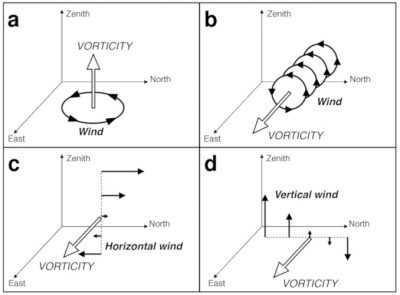| Focus
1/1 | Tornadoes: powerful devastating eddies
Wind and vorticity vectors
PDFWind is the speed of the air relative to the ground. It can be represented as a 3-dimensional “Vector” according to the 3 reference directions: west-to-east, south-to-north, nadir-to-zenith. Vorticity” characterizes the rotational movements of air. It is also a vector whose components according to these 3 directions are proportional to the variations of the transverse components of the wind in perpendicular directions. Thus, purely horizontal vortices have a purely vertical vorticity (Figure 1a). A vertical circulation (Figure 1b) around a horizontal axis, a vertical variation (also called “Vertical Shear“) of the horizontal wind (UZ, VZ) (Figure 1c), or a horizontal variation of the vertical wind (Figure 1d) produce horizontal vorticity.





